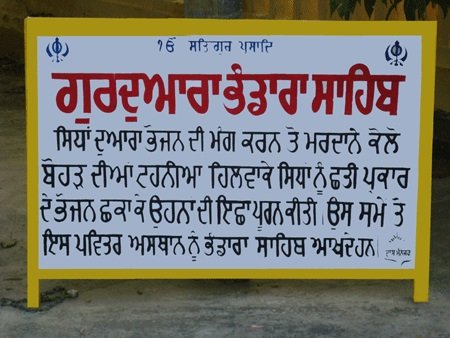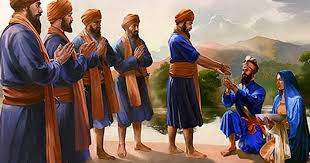Unlock the meaning of 'Amrit' - symbolic of immortality and divine sweetness in Sikh and Hindu traditions, beyond a mythical elixir.
BHAI, of Indo Aryan origin (Sanskrit bhratr, Pali bhaya), means brother in its literal sense and is employed as an honorific as well as in the dominant familial sense and as a title of affection between equals. It has been used in the Guru Granth Sahib in the latter sense and there are several apostrophic examples none of which seems to imply any special rank or status. However, by the middle of the seventeenth century, it was being used as a title implying distinction: the earliest example is the Bala Janam Sakhi (AD 1658) which refers to its putative author as Bhai Bala. The naturalness of its use in this particular context suggests that it must have developed the honorific connotation even earlier though it does not necessarily follow that these connotations were clearly apprehended in earlier usage.
Explore the rich tradition of Bhandara in Sikh culture—feasts open to all, celebrating community and devotion, echoing the spirit of guru ka langar.
DERA, a word of Persian extraction, has several connotations. The original Persian word derah or dirah means a tent, camp, abode, house or habitation. In current usage in rural Punjab, a farmhouse or a group of farmhouses built away from the village proper is called dera. Even after such an habitation develops into a separate village or a town, it may continue to be called dera, e.g. Dera Bassi in Patiala district of the Punjab, or Dera Ghazi Khan and Dera Isma`il Khan in Pakistan. Where colloquially used in place of Hindi dehara, the word will carry the connotation of a temple or memorial over a cremation site.
FIVE KHANDS or Panj Khands, lit. realms (panj == five, khand == region or realm), signifies in the Sikh tradition the five stages of spiritual progress leading man to the Ultimate Truth. The supporting text is a fragment from Guru Nanak`s Japu, stanzas 34 to 37. The Five Realms enumerated therein are dharam khand, the realm of righteous action (pauri 34), gian khand, the realm of knowledge (pauri 35), saram khand, the realm of spiritual endeavour (pauri 36), karam khand, the realm of grace, and sach khand the realm of Truth (pauri 37).
Explore the depths of 'Gurmukh' in Sikh scripture. Uncover the God-inspired path leading to truth, righteousness, and spiritual enlightenment.
Explore the concept of Moh, its impact on perception and reality, and why shedding attachment leads to spiritual enlightenment in Sikhism.
Explore the meaning of 'Panth'—a way of life and religious path in Sikhism, embodying the collective faith and commitment of the Sikh community.
Explore the historical and spiritual significance of Sarbatt Khalsa, the integrated conscience of the Sikh community and its supreme governing body.
Discover how seva, the profound act of service in Sikhism, merges devotion and duty. Learn its significance in spiritual life and community service.
- 1
- 2










